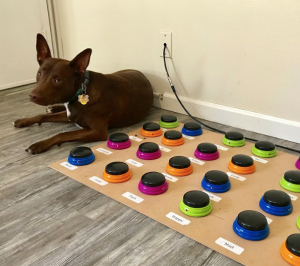
Finding The Off Button can be a challenge for a puppy like Travis. As well as getting the balance between stimulation and exercise right, it is important to ensure that dogs get sufficient rest and good quality sleep.
Teaching a settle is a “foundation behaviour” that tended only to be taught by traditional trainers as an “obedience” exercise. But think how many times during any given day that you need your dog to settle down – after a walk, in a café, waiting for a vet appointment or a bus, while you are working from home…etc etc
As a herding breed, Travis drops into a down at – well – the drop of a hat. I didn’t need to make an effort train it, although I have put it on cue. What he can’t manage yet is to stay there. This is to be expected of an adolescent dog and we will work on building it as he matures. Getting him to actually settle is quite another matter.
Usually, I teach a settle on a mat in the first couple of sessions with every dog. The mat helps the dog to focus and understand what is required. Young dogs often nibble at the corner of the mat until they learn that they get rewarded for other forms of contact with it instead, but Travis was solely focused on wrecking it and didn’t even pay attention to high value treats. By the time that I started to train it (much later than usual), “sit” and “down” were on cue and I realised that he didn’t need the help of the mat.
I have always been reluctant to advise using a crate as it is tempting for owners to rush training, bundle the dog in and then and leave him for longer than he can manage. I finally gave in as I simply needed to be able to leave Travis alone and ensure that he – and my possessions – were safe.
Then I wondered why I had waited for so long! Travis went through an excellent socialisation plan with his breeder and we liaised in this as soon as he was born. By the time that he came to me at 8 weeks old, he was very happy being left in a crate for short periods, loved travelling in a car and was a very well-adjusted little fellow. He loves the crate.
Most importantly, it has provided somewhere more defined for him than a mat or even his bed, where he can switch off automatically. It sometimes takes a while for him to wind down, but he often hops in to have a snooze during the day and -as I discovered – when he knows I am about to go out.
Hooray I’ve found an off button at last!
Next week: Gone But Not Forgotten
If you need help with helping your dog to settle, go into a crate or to add a cue to behaviour and make it reliable, contact R+ Dog Training now.

